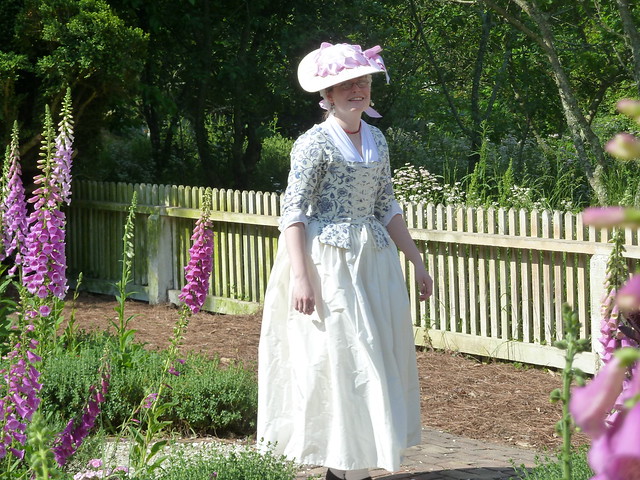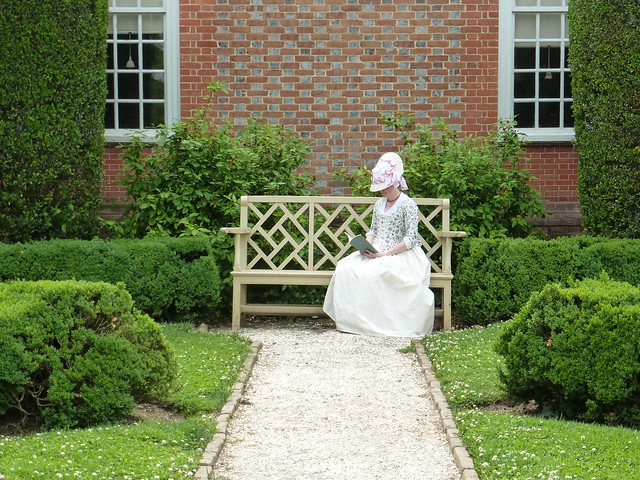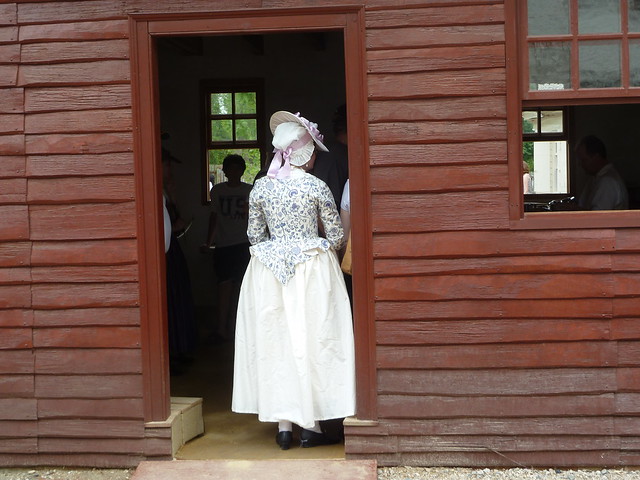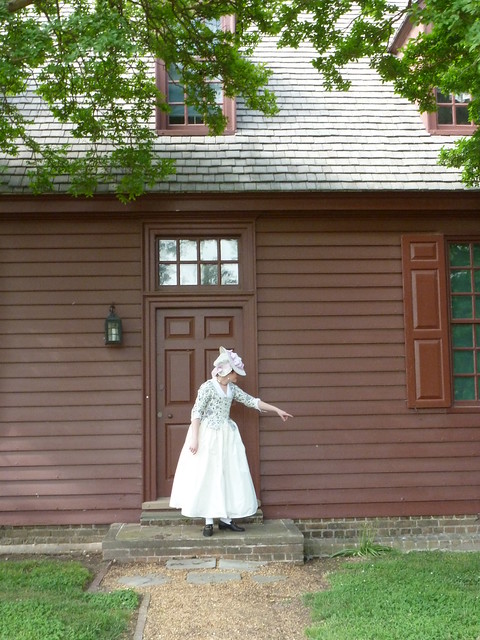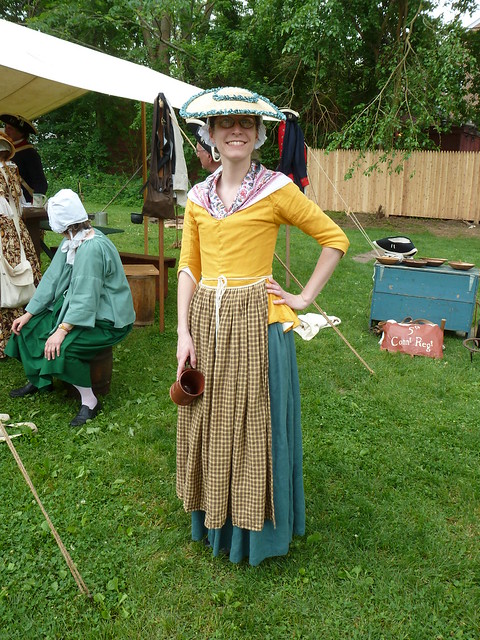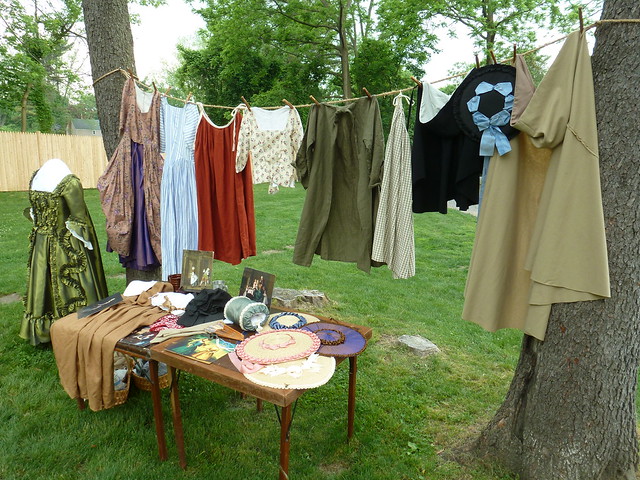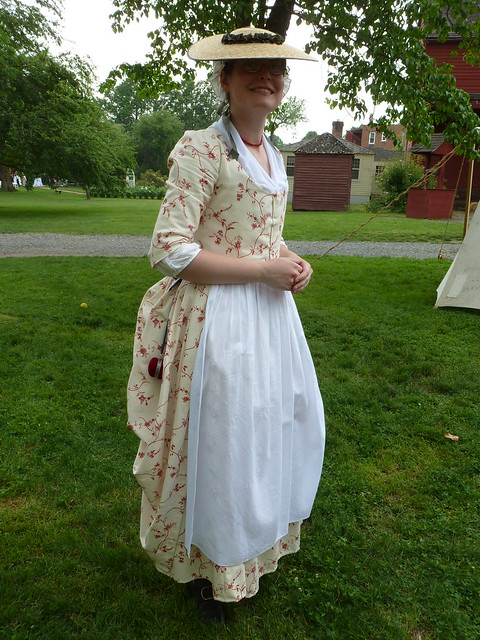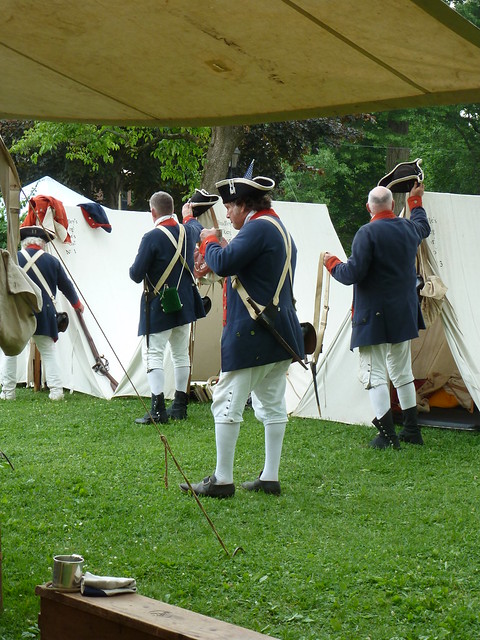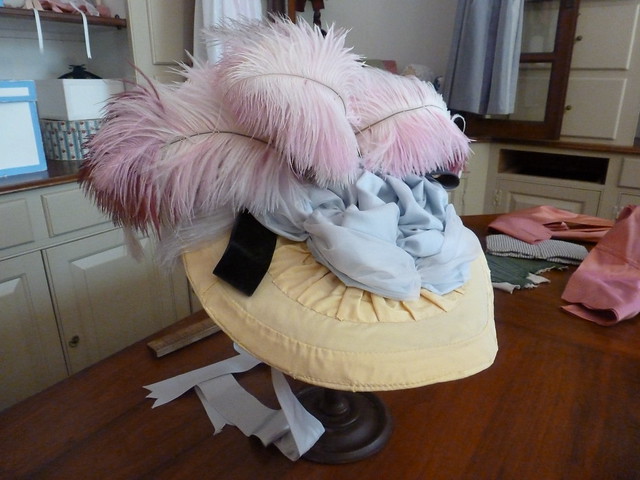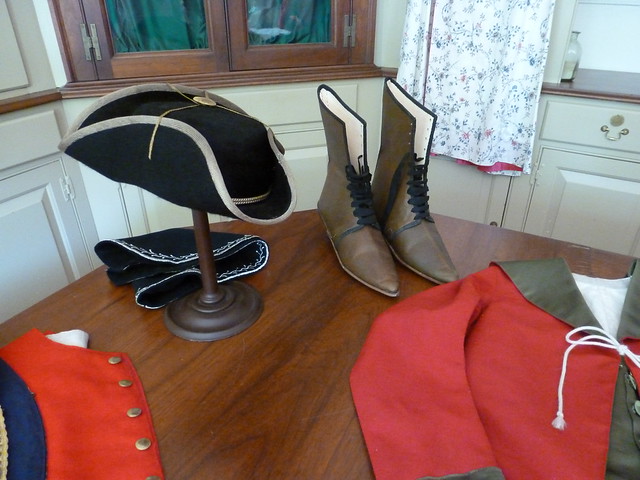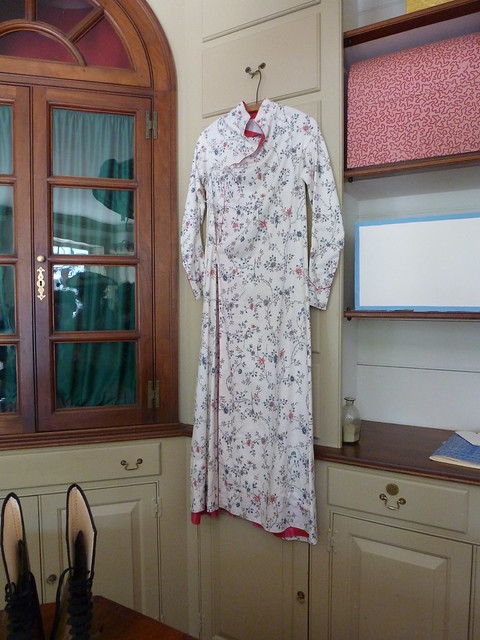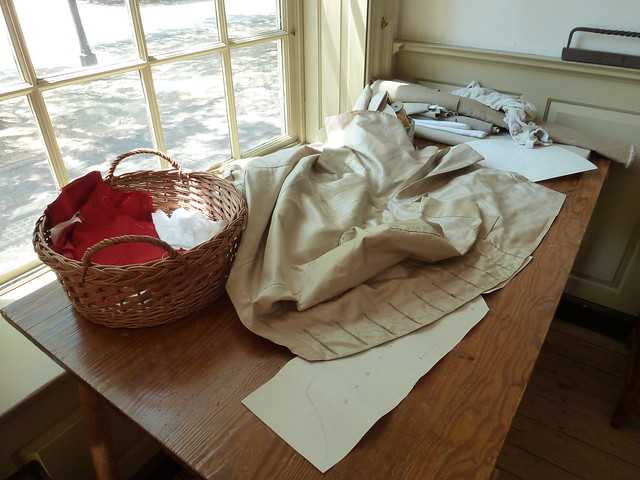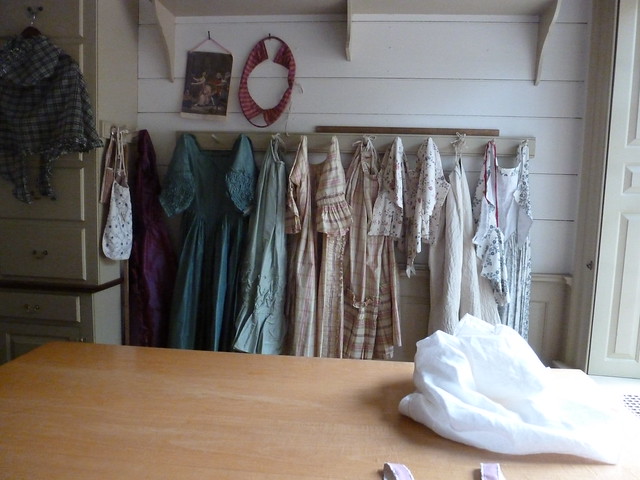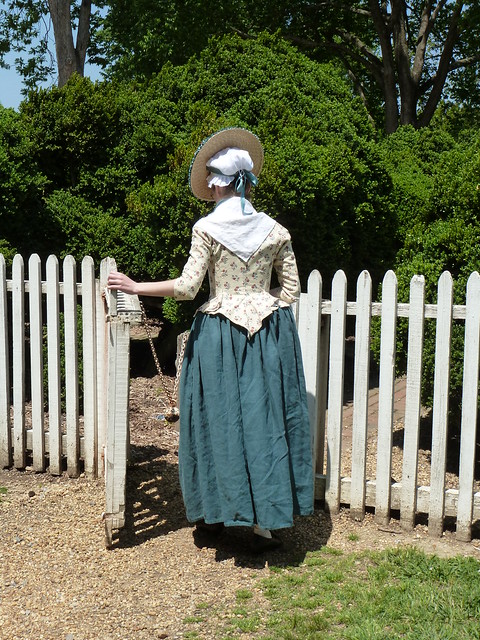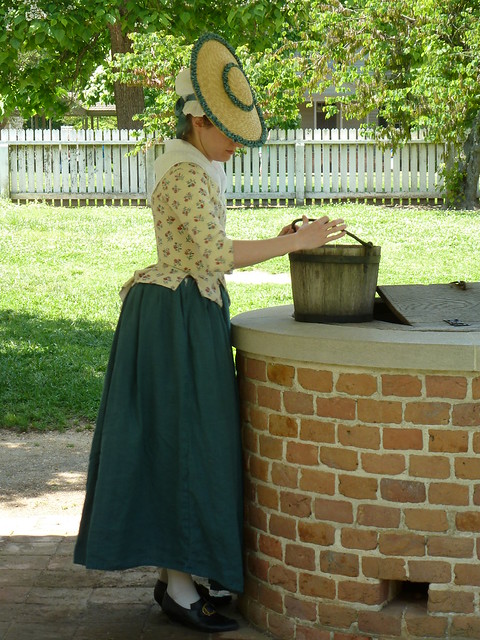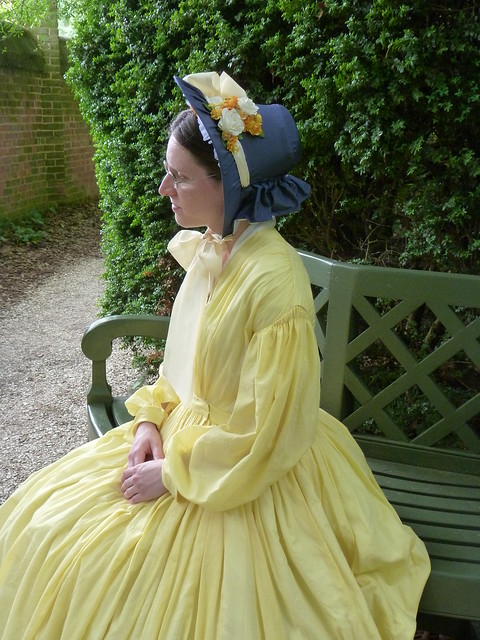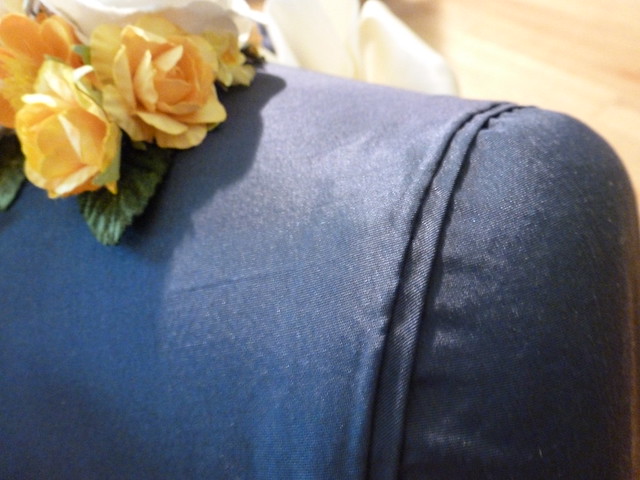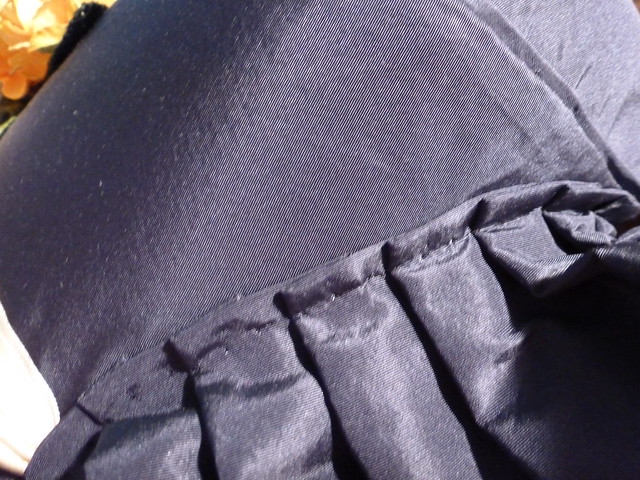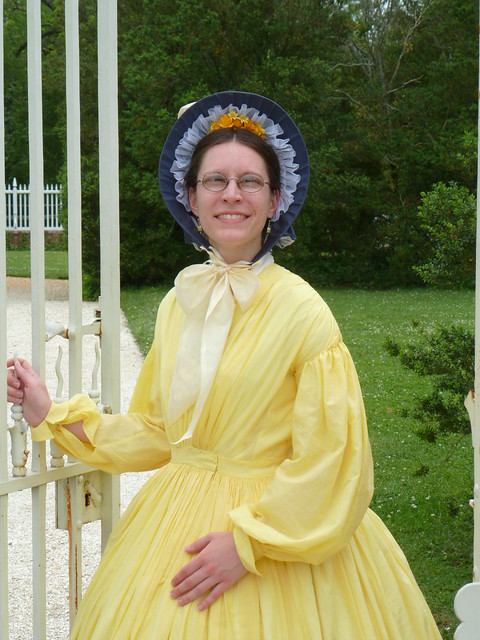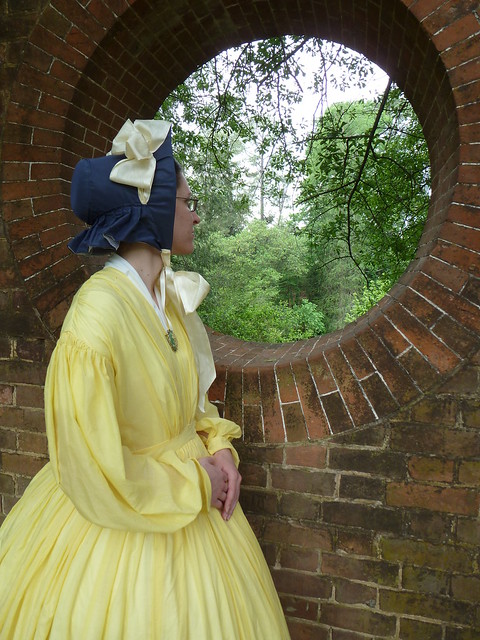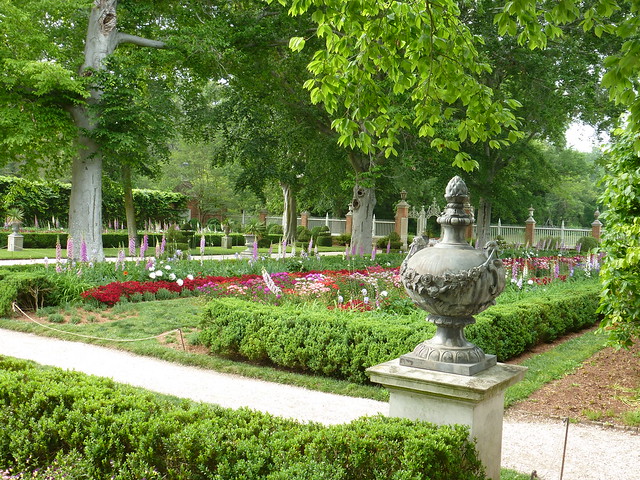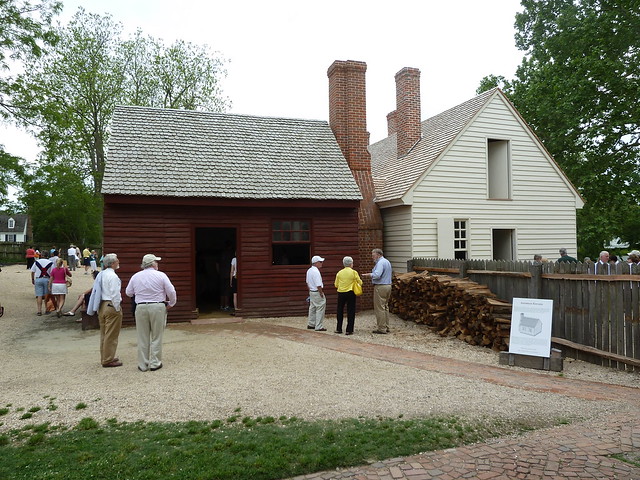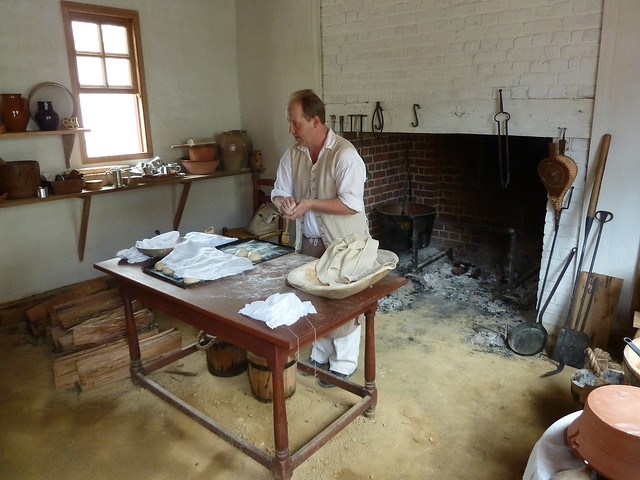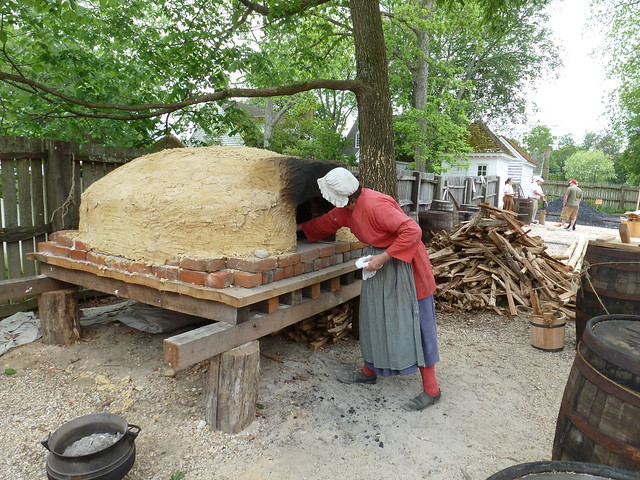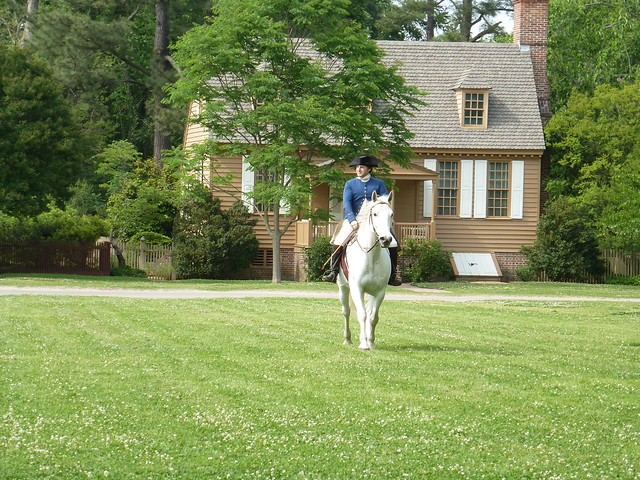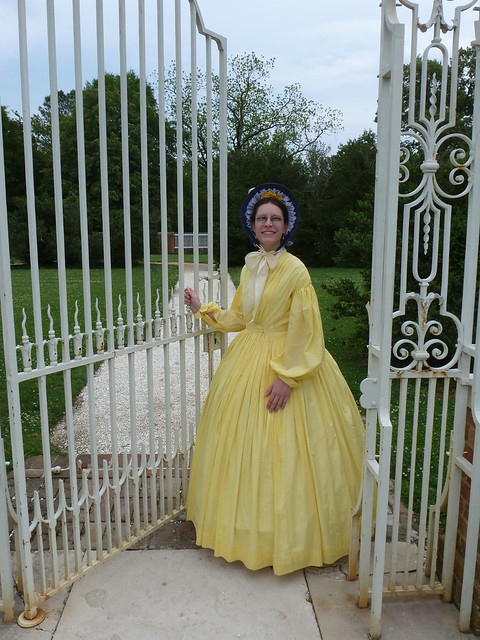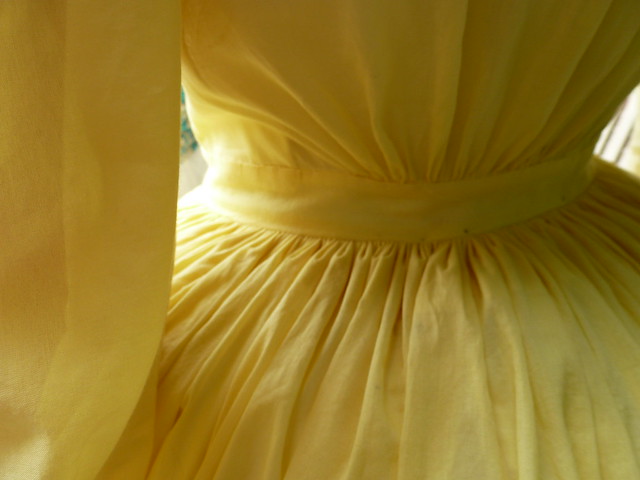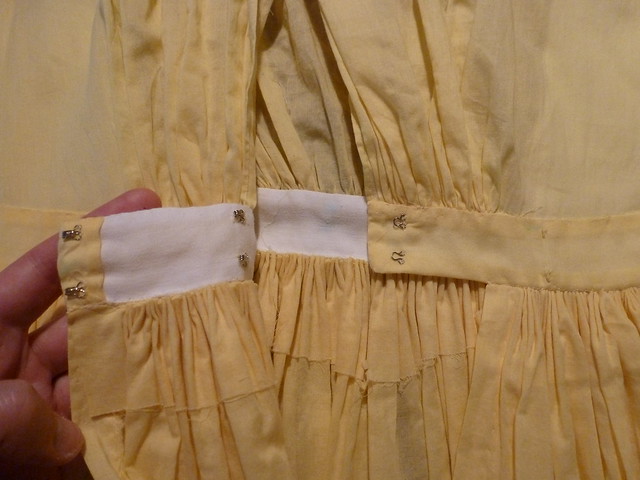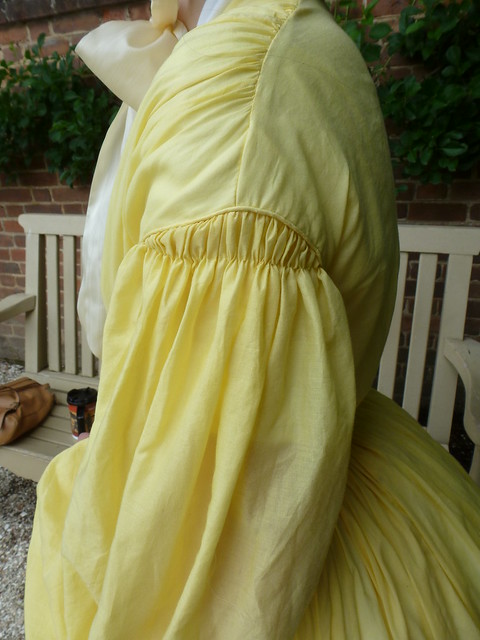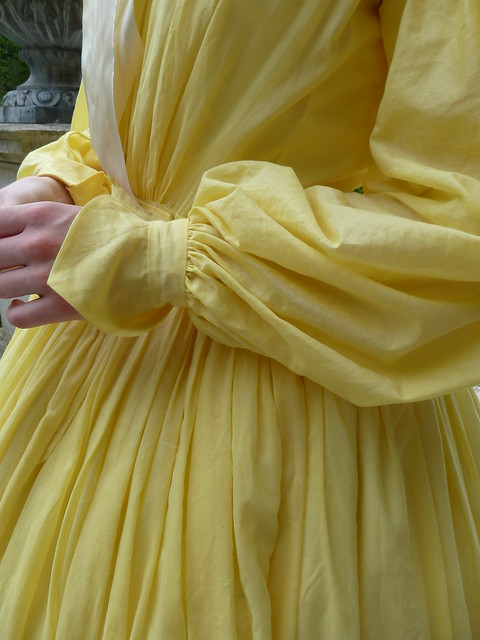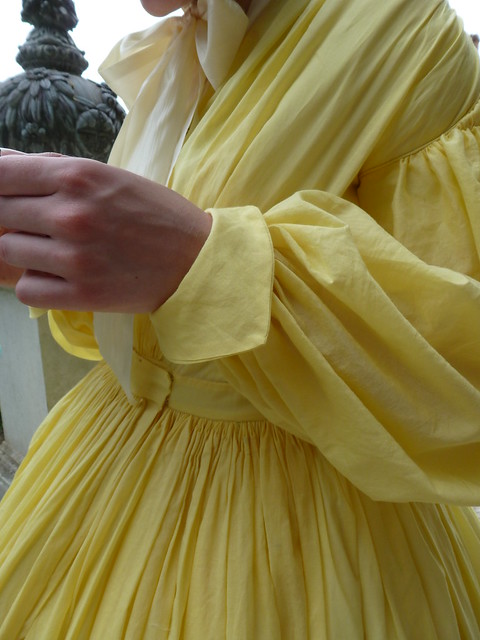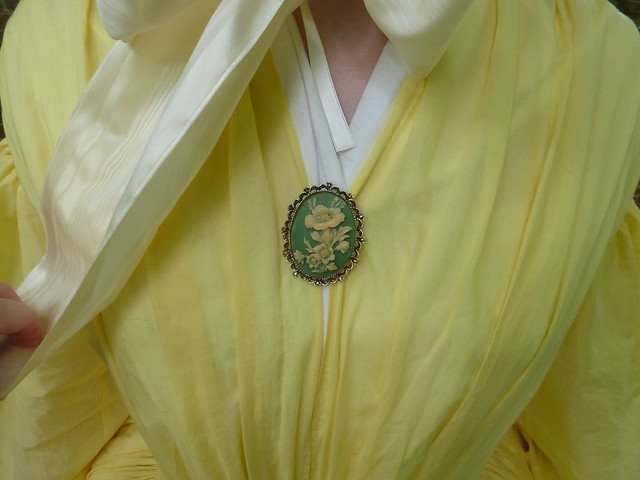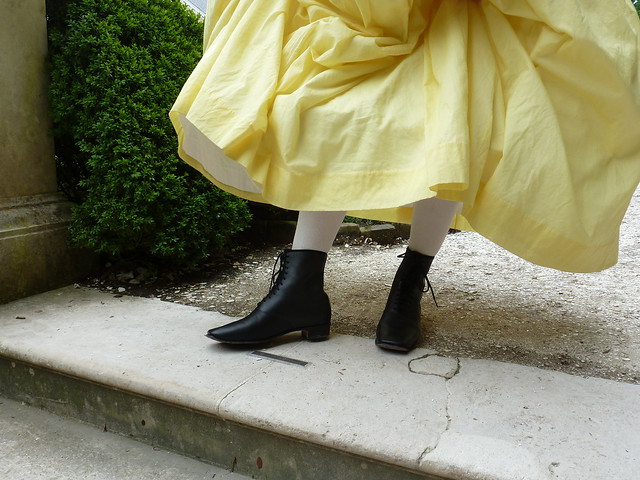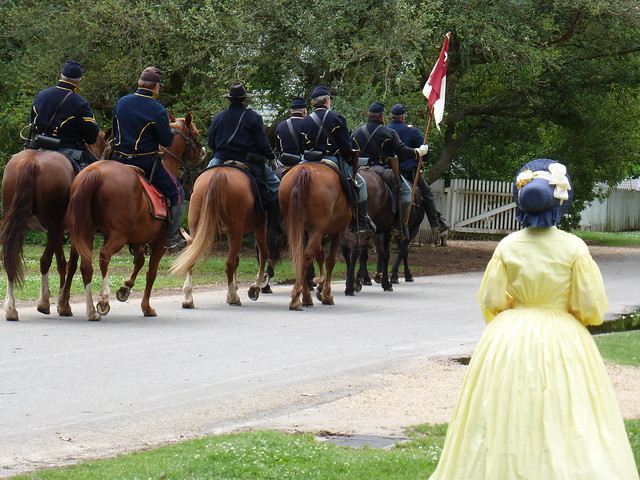A Sheer Yellow Cotton Dress of the Early 1860s
Colonial Williamsburg, May 2012.
The pattern: As this was my first experience with an 1860s garment, I elected to begin with a pattern - the
Peachtree Mercantile dress - which reproduces an original in the collection of the
Atlanta History Center. The sheer number of mid-century patterns currently available was a little overwhelming at first, but after some research into cuts and styles, and after reading about the experiences other seamstresses have had with many of the patterns, I selected this one because it includes what can easily be called a "crash course" in mid-century construction technique, with meticulous and clear instructions that aid in the production of a genuine reproduction piece. In the end, I couldn't have been more pleased with the pattern, and adamantly recommend it.
 Colonial Williamsburg, May 2012.
Colonial Williamsburg, May 2012.
Inspirations: The original dress is made in a semi-sheer, light-weight printed cotton. Ashely knew she wanted something appropriate for wear in summer heat (further Civil War events are in the works!), so she began her image inspiration search with sheer dresses, which were extremely popular in the first half of the 1860s. These are some of our favorites that led us to select this particular pattern and Ashley's choice to make it using a sheer cotton voile.
An 1860s sheer cotton gown from the private collection of K. Krewer.
Sheer dresses were lined in a variety of ways. Those with round jewel necklines could have a "full" or "high" lining which extended from the waist to the neck, or a "half" lining that left the shoulders mostly bare and replicated the look of a low-cut evening bodice. V-necked sheer dresses typically used this "half" lining or one that was even more minimal, being just a partial lining that helped support the armscye and side-seam areas only. The Peachtree/Atlanta dress features this last style of lining, but Ashley really likes the look of the low neckline beneath the sheer, as seen in the portrait below, so we used that cut for the petticoat body (corset cover) that she wore underneath to prevent her corset from showing through the sheer cotton.
An 1860 American portrait from the El Paso Museum of Art.
Construction details: Because I used a pattern for this project, which I don't normally do, I can't go into as great an amount of detail as is typical of "Threaded Bliss" because the pattern directions are, of course, copyrighted. I will, however, give a brief overview of how this dress is put together, and of some of the interesting little features it has that helps make it so drastically different from our well-loved and much-familiar 18th-century clothes.
In keeping with the original, this dress is entirely hand sewn. It has a gathered (or "O") bodice, with the fullness concentrated in tiny gathers along the center front and center back, and along the shoulders.
A detail view of the back waistband, showing the bodice gathering
concentrated at center back, and the tiny gauging that
controls the fullness of the skirt.
The only fastenings on the bodice are four sets of hooks and eyes on the waistband. The dress, like the original, closes off-center, a slight variation on the "standard" dog-leg closure, but still very efficient in preventing gaps as the skirt falls from the center front.
The modified dog-leg closure that replicates the original. You can also see
the excess fabric from the shaping of the skirt hanging down inside.
The armscyes of the dropped shoulders are piped, as is typical of the majority of dresses dating from this period.
Piping finishes the armscye.
As I mentioned above, the dress has only the most minimal of linings; white cotton supports the armscyes and side seams, as well as the waistband, but other than that, the dress is simply a single layer of voile.
The partial lining of the bodice.
If you're interested in exploring construction details in more depth, check out this
original 1865 sheer bodice on Katherine's site. With the exception of the neckline and center-front closures, the construction is nearly idential to our dress and the Peachtree/Altanta original, from the reinforced shoulder seams to the angle of the shoulders/sleeves, to the concentration of the pleats to the piping around the armscyes to the partial lining.
Because the Peachtree/Atlanta dress only has a partial lining, with just the armscyes and side seams lined, a corset cover (known as a petticoat body/bodice) must be worn underneath to keep the corset from showing through the very sheer voile. I used
this 1862 pattern from Peterson's to create one, and if Ashley did not have the neckerchief on covering her shoulders, the neckline of the lining would look just like the one in the 1860 inspiration portrait above.
The bishop sleeves have a row of gathering stitches along the sleeve cap to help control their fullness. At the bottoms, they are gathered into a band and then finished with a horseshoe cuff that folds up and over to conceal the wristband. The sleeve bands fasten with two sets of hooks and thread eyes.
The top of the sleeves have a single row of gathering stitches
to help control their fullness.
The sleeves are finished with a band and cuff. Here, the cuff
is folded down to reveal the band...
...that is concealed by the cuff when it is turned up to be worn properly.
As in eighteenth-century gown skirt and petticoat construction, the hem of the dress is on the straight grain. All adjustments in skirt length necessary to accommodate the shape of the cage crinoline are made at the waist; excess fabric is not cut, but instead folded in so that the pleats at the top of the skirt actually contain two layers of fabric. The hem - a 3" deep one common for this period - is made only of folded self-fabric. While gowns of more opaque fabric tended to be faced (and sometimes bound) at the hemline with another textile and/or tape to help protect the hem from wear, sheer dresses tended to use only a simple folded hem.
The fabric: A delightfully sheer cotton voile in "sunshine" yellow. The gown is only lined around the armscyes and side seams, in a plain-weave white cotton.
Finishing the look: This dress, like the original, has no fasteners other than at the waistband. This means it must be pinned closed at the V-neck, either over a chemisette or a neck handkerchief. Ashley recently purchased a gorgeous green vintage floral cameo brooch that proved to be the perfect match in color and size for just this purpose. The pin secures dress and handkerchief at once.
A vintage floral cameo secures the front of the bodice closed
over a white cotton neck handkerchief.
Because of the extreme sheerness of the fabric of the unlined skirt, the dress is worn over an underpetticoat of medium-weight cotton, which also helps obscure the lines of the cage crinoline from showing through the outermost skirt layer. A red corset of cotton sateen (more on this to come soon!), worn over a cotton batiste chemise and drawers provide the requisite underclothing to support the dress, to lend it the proper early-1860s silhouette, and to help keep it clean from body oils.
A pair of Robert Land Balmoral boots and antique silver and amber earrings complete the outfit, along with a blue silk bonnet trimmed to coordinate with the voile (more to come on that as well!).
Showing off the new boots!
Colonial Williamsburg, May 2012.
Commemorating the 150th anniversary of the Battle of Williamsburg.
Colonial Williamsburg, May 2012.
Coming soon are additional posts that will take a look at the bonnet, the corset, and the underpinnings. In the meantime, additional photos of the dress can be found on in its
flickr set.

